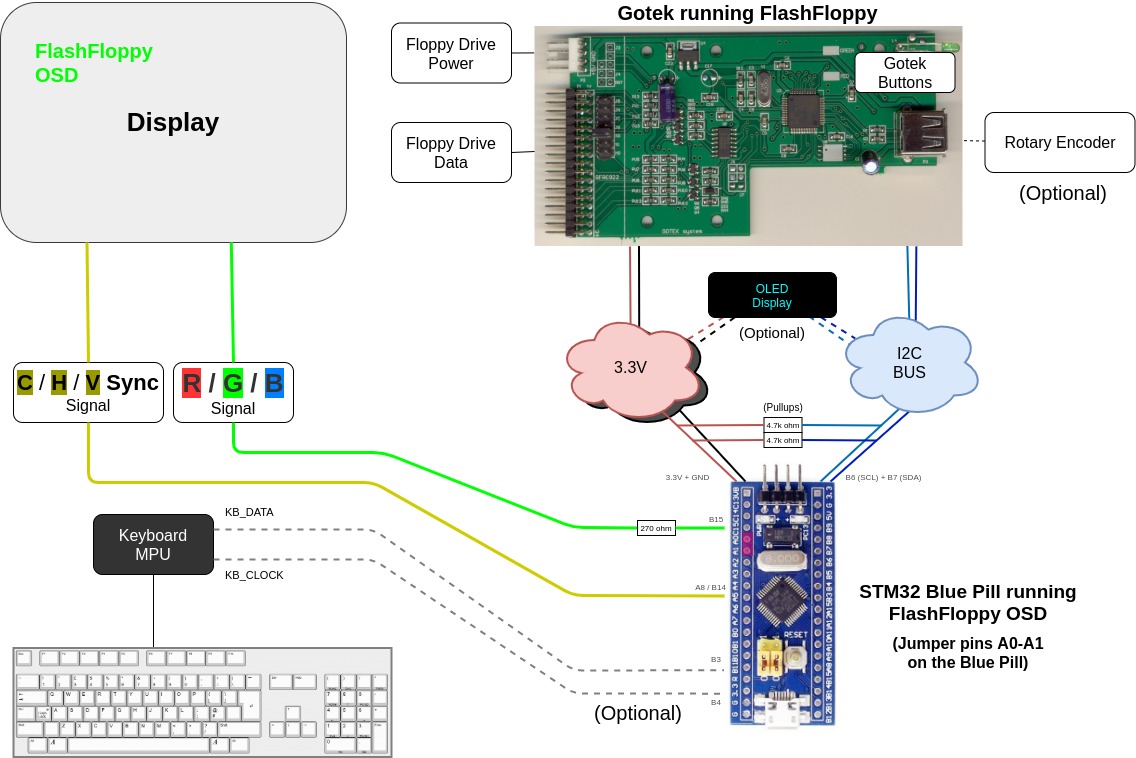-
Notifications
You must be signed in to change notification settings - Fork 16
Hardware Connections
The following diagram summarises the connectivity options described in detail later in this page.

Connect to the Gotek display header as described in the FlashFloppy wiki for connecting an OLED display. In place of the OLED display (or alongside: see below!) you will connect FF OSD as follows (Signal = Pin):
- SCL = B6
- SDA = B7
- VCC = 3.3
- GND = G
Also note that SCL (B6) and SDA (B7) must each be connected, by a separate 4.7k resistor, to 3.3v (3.3). These two resistors can be soldered in place on the FF OSD board. Be careful not to allow the resistor legs to touch other pins!
Caution: Do not connect 3.3 to 5v on the Gotek!
IMPORTANT: When connecting to a FlashFloppy Gotek you should place a jumper across pins A0-A1 and run the latest stable release of FlashFloppy (latest v3.x). This enables a range of desirable features:
- Enhanced 3 rows and up to 40 columns output
- Gotek control via Amiga keyboard
- OSD configuration via Gotek input (buttons or rotary encoder)
- I2C bus sharing with an LCD or OLED display
OSD alongside LCD/OLED: Dual display requires both FF OSD and the LCD/OLED to be connected to the Gotek display header, for example by creating splitter wires to connect each Gotek header pin to the LCD/OLED and to FF OSD. You may still require the 4.7k pull-up resistors on B6 and B7.
Connect to the CSYNC and one of Red, Green, or Blue analogue video signals as follows:
- CSYNC = A8
- R,G,B = B15 (NB. Connect via approx 270-ohm resistor!)
The exact connection points will vary by machine model. There may be a machine-specific wiki page for connections to your computer (eg Amiga).
In machines with no CSYNC, but which have separate HSYNC and VSYNC, the sync connections become:
- HSYNC = A8
- VSYNC = B14
Optional: FF OSD and the attached Gotek may be controlled entirely via Amiga keyboard. This requires connection to the Amiga's keyboard serial line as follows:
- KB_DATA = B3
- KB_CLOCK = B4
IMPORTANT: Blue Pill pins A0-A1 must be jumpered for keyboard controls to be forwarded to the Gotek.
These signals can be found at pins 39 and 40 of CIA-A (U7) on an Amiga 500. Or pins 43 and 44 of CIA-A (U7) on an Amiga 600 or 1200. For more details and pictures see the Amiga page.
Now the following key bindings take effect when L.Ctrl and L.Alt are held:
- Left Arrow = Prev
- Right Arrow = Next
- Up Arrow = Select
- Help = FF OSD Configuration Menu
- Del = Toggle OSD On/Off
L.Ctrl+L.Alt+Return steals the keyboard: hot keys will now work without needing to continue holding L.Ctrl and L.Alt. Press the same three-key combination to release the keyboard back to the Amiga.